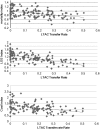The implications of long-term acute care hospital transfer practices for measures of in-hospital mortality and length of stay
- PMID: 21940788
- PMCID: PMC3361349
- DOI: 10.1164/rccm.201106-1084OC
The implications of long-term acute care hospital transfer practices for measures of in-hospital mortality and length of stay
Abstract
Rationale: The National Quality Forum recently endorsed in-hospital mortality and intensive care unit length of stay (LOS) as quality indicators for patients in the intensive care unit. These measures may be affected by transferring patients to long-term acute care hospitals (LTACs).
Objectives: To quantify the implications of LTAC transfer practices on variation in mortality index and LOS index for patients in academic medical centers.
Methods: We used a cross-sectional study design using data reported to the University HealthSystem Consortium from 2008-2009. Data were from patients who were mechanically ventilated for more than 96 hours.
Measurements and main results: Using linear regression, we measured the association between mortality index and LTAC transfer rate, with the hospital as the unit of analysis. Similar analyses were conducted for LOS index and cost index. A total of 137 hospitals were analyzed, averaging 534 transfers to LTAC per hospital during the study period. Mean±SD in-hospital mortality was 24±6.4%, and observed LOS was 30.4±8.2 days. The mean LTAC transfer rate was 15.7±13.7%. Linear regression demonstrated a significant correlation between transfer rate and mortality index (R2=0.14; P<0.0001) and LOS index (R2=0.43; P<0.0001).
Conclusions: LTAC hospital transfer rate has a significant impact on reported mortality and LOS indices for patients requiring prolonged acute mechanical ventilation. This is an example of factors unrelated to quality of medical care or illness severity that must be considered when interpreting mortality and LOS as quality indicators.
Figures



Comment in
-
Measuring and rewarding quality in the ICU: the yardstick is not as straight as we wish.Am J Respir Crit Care Med. 2012 Jan 1;185(1):3-4. doi: 10.1164/rccm.201110-1813ED. Am J Respir Crit Care Med. 2012. PMID: 22210782 No abstract available.
References
-
- Aebersold A NQF endorses patient outcome measures for high-impact conditions. Washington, DC: National Quality Forum; 2010
-
- Peterson KGK, Schraufnagel D. Letter to the NQF Steering Committee. Washington, DC: National Quality Forum; 2010. p. 3
-
- Hotes LS, Kalman E. The evolution of care for the chronically critically ill patient. Clin Chest Med 2001;22:1–11 - PubMed
-
- Medicare program: prospective payment system for long-term care hospitals RY 2007: annual payment rate updates, policy changes, and clarification. Final rule. Fed Regist 2006;71:27797–27939 - PubMed
-
- Kahn JM, Kramer AA, Rubenfeld GD. Transferring critically ill patients out of hospital improves the standardized mortality ratio: a simulation study. Chest 2007;131:68–75 - PubMed
Publication types
MeSH terms
Grants and funding
LinkOut - more resources
Full Text Sources

